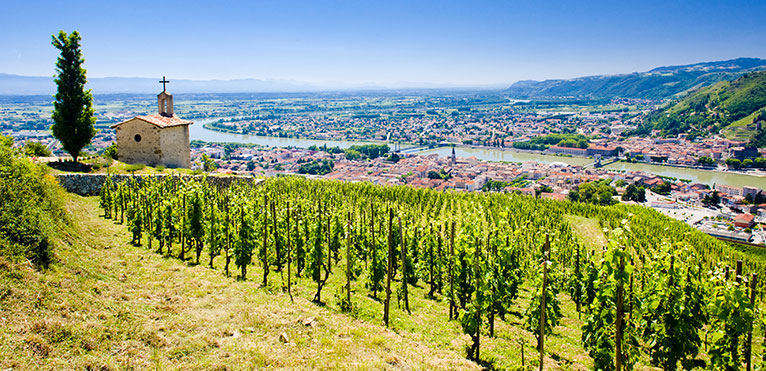
Contents
In the southern part of the Rhône Valley, at the gateway to the Languedoc region, lies Costières de Nîmes. This appellation, like some of the 28 others in the region, mainly produces red wines, which account for just over half of production. The Appellation d’Origine Contrôlée (AOC) label was awarded in 1989.
Costières-de-Nîmes, a wine with its own emblem to recall its history
The appellation’s fertile soils were discovered by the Greeks, who planted the first vines here. Later, the Romans’ trading skills enabled the vineyards to expand. However, the phylloxera crisis at the beginning of the 19th century put the brakes on vineyard growth.
The at the end of World War II that the AOC began to take off, with the creation of a clear identity for this wine, which bears theemble of the Roman colony that settled where the Costières de Nîmes appellation has its roots.
Today, the main wine lovers to praise the superior quality of these reds, whites and rosés are the Nîmes themselves, who are very proud of them. But this enthusiasm is increasingly shared, and a wider public now recognizes the excellence of Costières de Nîmes.
Costières-de-Nîmes, a perfect blend of climate and terroir
Costières de Nîmes is produced on 4,350 hectares of terroir composed mainly of clay-limestone, pebbles and rounded pebbles.
The predominant climate in the Rhône Valley is Mediterranean, with alternating periods of rain and hot, dry summers. And it’s precisely this combination of terroir and the year-round mistral wind that keeps the vines in excellent shape. The clay in the soil keeps the vines hydrated in summer, and the pebbles allow excess water to drain away quickly when necessary in excessively wet weather.
Costières-de-Nîmes offer exceptional red and white wines for laying down
The reds and rosés are made from Syrah, the region’s king grape variety, accompanied by other traditional grape varieties such as Grenache and Mourvèdre to comply with regulations that require appellation wines to be a blend of at least two grape varieties. But the grape variety can be perfected with Cinsault or Carignan up to a maximum of 20%.
Visually, these two wine colors have a light but brilliant hue, with purplish tints when the wine is young, gaining in intensity with age thanks to the Syrah. These very fragrant wines reveal themselves on the nose with aromas of red fruits such as strawberry or raspberry and for reds, blackberry.
Costières de Nîmes red can be drunk young to enjoy its freshness, but it can also be kept for 3 to 5 years to discover new aromas of violets, black olives and spices. This also allows the tannins to refine and certain mineral aromas to emerge if Cinsault or Carignan have been included in the blend. Rosé is best enjoyed young, and is fresh and delicate.
For white wines, Grenache blanc, Roussane and Marsanne are the required grape varieties, and Clairette, Bourboulenc, Vermentino, Macabeu and Viognier may be added in smaller quantities. Its color is golden, with a certain brilliance. The nose is fruity, with citrus and other more exotic or white-fleshed fruits, as well as aromas of white flowers, such as acacia.
On the palate, we immediately recognize the aromas identified on the nose, which evolve towards honey flavors with age, giving this wine a lovely roundness. You’ll need to wait at least 3 years to fully appreciate the intense aromas this white has to offer.
Costières-de-Nîmes, a simple tasting experience
A red goes perfectly with Parmentier de boudin noir or a classic ratatouille niçoise, but more generally with grilled meats or raw cow’s milk cheeses. The ideal tasting temperature is 16°C.
AOC rosés go well with charcuterie or Mediterranean dishes such as chicken tagine with preserved lemon or mint tabbouleh. White Costières de Nîmes should be served at 8°C.
Cod-flavored potatoes are an ideal accompaniment for a white Costières de Nîmes, but more generally, you can think of Mediterranean fish or seafood. Drink chilled at 10°C.
Costières-de-Nîmes, fine vintages
The best vintages for Costières de Nîmes reds are: 1985, 1986, 1995, 2003, 2007, 2013. For an exceptional tasting, 2001 is the year to go for, and for whites, 2001 and 2005 are the best.
Only 1985, 1988, 2005, 2006 and 2007 are worthy of note for Costières de Nîmes rosés, years recognized as great vintages.
Costières-de-Nîmes, between modernity and history
Domaine de Poulvarel
This estate, which has only been in existence since 2004, is located to the north of the appellation. This family-run business has never ceased to surprise since its inception, offering wines in all three colors from environmentally-friendly vineyards. The estate is very modern and extends over 20 hectares.
Castle Or and Gules
An original name for a family estate whose history dates back to the 12th century. Today, the values of the people who work these lands – respect for the environment and the workers – contribute to the creation of wines that are original and unique. Winegrowers here cultivate 10 different grape varieties planted over 60 hectares to produce red and white wines.
Discover the best Costières de Nimes estates.